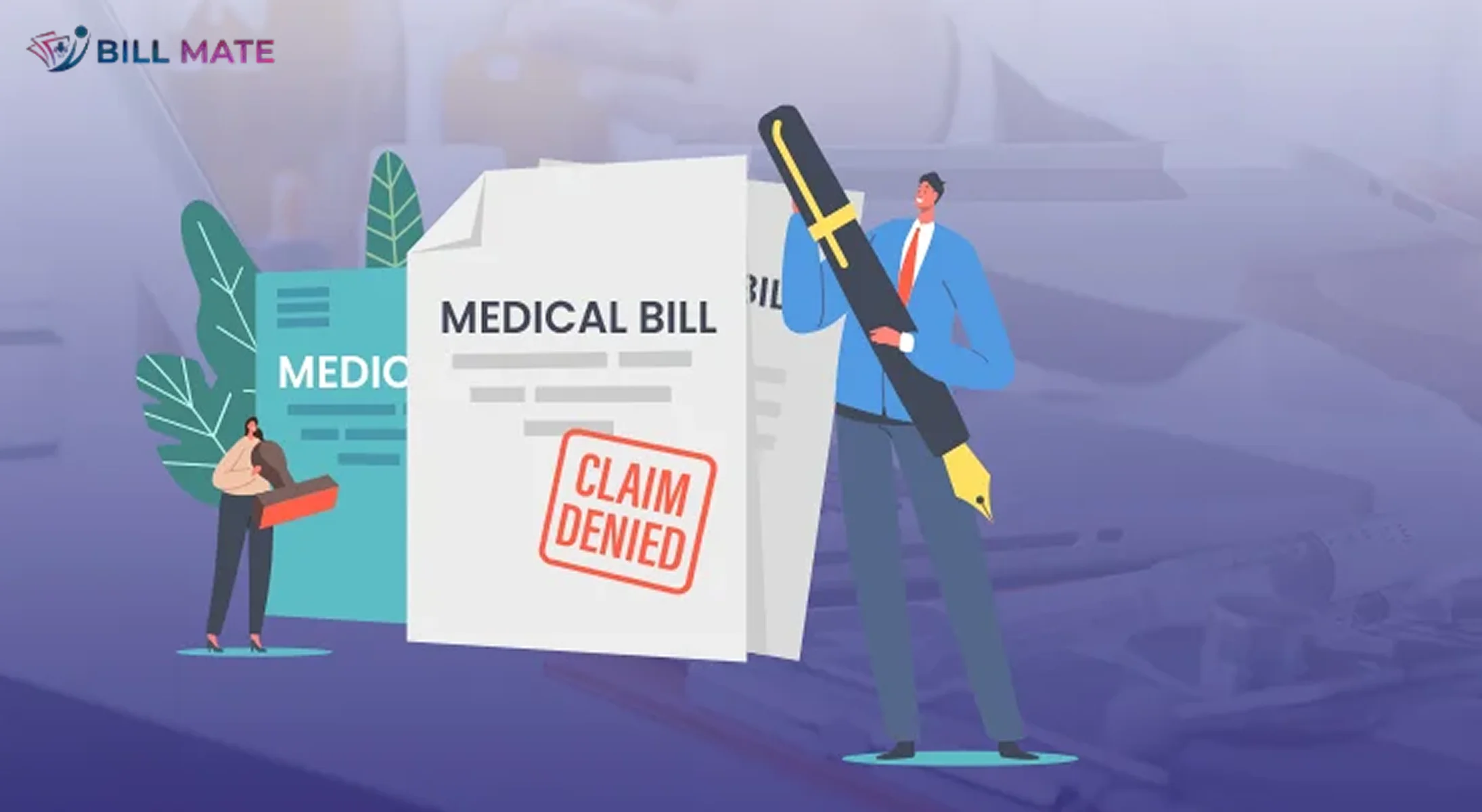
How Medical Billing Claim Denials Are Prevented: A Complete Guide
By Billmate
Sept. 24, 2025, 7:22 a.m.
Introduction

In 2025, medical billing claim denials remain one of the top challenges for doctors, clinic managers, and hospitals. Each denial not only delays reimbursement but also adds administrative costs and impacts patient trust. According to the Centers for Medicare & Medicaid Services (CMS), around 5–10% of medical claims are denied, and most are preventable.
This guide will walk you through how to prevent claim denials, the most common reasons for claim denials, and the strategies healthcare providers can adopt to reduce errors and protect revenue.
Why Do Medical Claims Get Denied?
Understanding why medical claims get denied is the first step toward prevention. The most frequent causes include:
-
Medical billing errors such as incorrect CPT or ICD-10 codes
-
Incomplete documentation, missing authorizations, or unclear notes
-
Insurance coverage issues, where services fall outside plan benefits
-
Late submissions that miss payer deadlines
-
Eligibility problems, such as inactive insurance at the time of service
These factors may seem small, but collectively they cost healthcare providers millions of dollars every year.
The Financial and Operational Impact of Claim Denials

Denied claims do far more than reduce revenue. They increase administrative workload, slow down cash flow, and create unnecessary patient frustrations.
-
Reworking a single denied claim costs an average of $25–$118 (AAPC).
-
Payment cycles can be delayed by 30–90 days, impacting cash flow.
-
High denial rates damage patient trust, as patients are often caught in billing disputes.
By focusing on denial prevention, providers can recover lost revenue and strengthen patient relationships.
How to Prevent Claim Denials: Key Strategies

-
Accurate Claim Submission
Accurate claim submission is the cornerstone of denial prevention. This includes verifying patient demographics, double-checking insurance details, and using correct coding. Providers who adopt claim submission accuracy in healthcare systems see fewer errors and faster reimbursements.
-
Insurance Eligibility Verification
Eligibility issues are one of the most common reasons for claim denials. Clinics should confirm coverage at the time of scheduling and again at check-in. Real-time eligibility checks can help avoid unnecessary rejections.
-
Strong Documentation Practices
A lack of detailed clinical documentation leads to denials. Linking medical notes directly to billing codes ensures accurate claim submission and better compliance with payer requirements.
-
Healthcare Billing Best Practices
Many denials stem from inconsistent workflows. Clinics should adopt:
-
Automated claim scrubbing tools
-
Staff training on coding updates
-
Standardized submission procedures
Together, these practices reduce the chance of medical billing errors.
-
Effective Denial Management Process
Even with prevention, some denials will happen. A structured denial management process allows providers to track, categorize, and appeal rejected claims. Reviewing denial patterns is critical to identifying systemic issues.
Steps to Prevent Insurance Denials in 2025
Healthcare organizations can build strong prevention systems by focusing on:
-
Eligibility checks at registration to ensure services are covered
-
Pre-authorizations for procedures that require payer approval
-
Automated billing systems that catch coding errors
-
Regular compliance audits to align with CMS and payer guidelines
-
Ongoing staff training to keep teams updated on policy changes
These steps form the foundation of effective claim denial prevention strategies.
What Is Claim Denial Management?

Claim denial management is not just about fixing rejected claims. It’s a cycle of:
-
Identifying causes of denied claims in healthcare
-
Correcting errors and resubmitting quickly
-
Tracking outcomes to prevent repeat issues
When done correctly, it ensures denied claims are not simply reworked but are learned from, reducing future rejections.
Explore professional support at BillMate Medical Billing Services
Strategies for Long-Term Denial Prevention
In 2025, technology is transforming the way denial management works.
-
Automation and AI: Claim scrubbing software powered by AI reduces medical billing errors.
-
EHR/EMR Integration: Linking billing with clinical records ensures accurate coding.
-
Analytics: Reporting tools highlight recurring denial reasons for proactive corrections.
-
Patient Education: Educating patients about their insurance plans prevents disputes and rejections.
These strategies improve efficiency, enhance compliance, and maximize reimbursements.
Fixing Denied Medical Claims

No matter how careful you are, some claims will still be denied. The process of fixing denied medical claims typically involves:
-
Reviewing the denial code for the specific rejection reason
-
Correcting missing or inaccurate information
-
Preparing supporting documents for the appeal
-
Resubmitting the claim within the payer deadlines
-
Timely follow-ups are essential to recover revenue and prevent backlog.
Conclusion
Medical billing claim denials are one of the most frustrating challenges in healthcare, but they are not unavoidable. With the right approach—focusing on accurate claim submission, thorough eligibility verification, strong documentation, and a proactive denial management process, healthcare providers can significantly reduce errors, improve acceptance rates, and accelerate reimbursements. By embracing technology-driven solutions such as automation, EHR integration, and analytics, clinics and hospitals can create a sustainable system that minimizes revenue loss and strengthens patient trust. In today’s competitive healthcare landscape, preventing denials is not just about financial stability, but also about ensuring patients receive uninterrupted, high-quality care.
Frequently Asked Questions
1: What is the most common reason for medical billing claim denials in 2025?
The top reason remains incorrect coding (CPT/ICD-10 errors), followed by incomplete documentation and insurance eligibility issues.
2: How can healthcare providers in the USA reduce claim denials?
By verifying patient eligibility in real-time, using automated claim scrubbing tools, and training staff on updated coding practices.
3: Do medical claim denial rates vary by state?
Yes, claim denial rates differ across U.S. states due to varying payer requirements. For example, clinics in Texas, California, and New York often face high denial rates because of stricter insurance policies.
Q4: What is the financial impact of denied claims for hospitals?
On average, reworking a single denied claim costs $25–$118, and delayed payments can disrupt hospital cash flow by up to 90 days.
Q5: How does claim denial management improve revenue cycle performance?
A structured denial management system reduces repeat errors, ensures faster resubmission, and improves overall claim acceptance rates.
Q6: Can outsourcing medical billing reduce claim denials?
Yes. Partnering with professional medical billing services like BillMate helps healthcare providers lower denial rates, improve compliance, and maximize reimbursements.
Q7: How does AI and automation help in preventing claim denials?
AI-powered claim scrubbing tools detect coding and documentation errors before submission, ensuring higher acceptance rates.
Q8: What should clinics do immediately after a claim is denied?
Review the denial code, correct errors, gather supporting documents, and resubmit within payer deadlines to avoid revenue loss.
Don’t let denials drain your resources.
Schedule Your Free Consultation Today and see how BillMate can help you prevent claim denials and maximize reimbursements.
What To Read Next

By Billmate | January 09, 2026
healthcare-recredentialing-deadlines
Learn healthcare recredentialing deadlines, challenges, and solutions to prevent denied claims, net…

By Billmate | January 07, 2026
Best 10 Medical Billing Companies in the USA for Accurate and Reliable Services for 2026
Explore the best 10 medical billing companies in the USA for 2026, offering reliable and compliant …

By Billmate | December 30, 2025
CPT Code 99214: Complete Billing, Documentation, and Compliance Guide
Complete CPT Code 99214 guide covering billing rules, documentation, diagnosis codes, compliance ti…

By Billmate | October 23, 2025
Doctors Sound the Alarm About Insurance Downcoding: How It’s Impacting Medical Billing & Clinic Rev…
Learn how insurance downcoding is reducing reimbursements and affecting medical billing accuracy in…

By Billmate | October 22, 2025
What Is Medical Billing? A Complete Guide for Healthcare Professionals
Learn what medical billing is, how it works, and why it’s essential for healthcare revenue. Discove…
Join our team to be a part
of our story
Learn more about our career, education and
posting jobs, and
submit simple application.